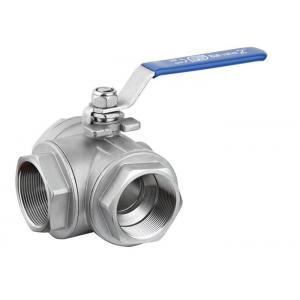Female Way Ball Valve 304 And 316 And 316L Stainless Steel DIN / ANSI Standard
1. Description:
This side entry 3 way ball valve offers diverting and mixing flow patterns and often eliminates the need for two valves. The full port design is easily automated and is available with various seat materials. The bolt on thread make for easy seat changes as necessary to accommodate your service. Easily automated!
Design: ANSI B 16.34
Testing: API598
2. Applications:
Illustrated to the right are the three normal operating positions for a three-way valve. Apollo’s three-way valve has only two
(2) seats as illustrated and as such has limitations for use in both diverter and mixing valve applications. As can be seen from this illustration, there is no off position for port “C”. Ports “A” and “B” cannot be off at the same time.
When ports “A” and “B” are the inlets, and port “C” is the out-let, the valve becomes a mixing valve. With minor variations in position 2 the percentage of components at “A” and “B” can be varied to the outlet “C”. This has been successfully applied to hydronic systems.
It may not be possible to isolate the ports from one another in any position. If the valve is in position 1, and the pressure at port “B” is significantly higher than port “A”, the ball may be forced off the seat allowing mixing from all ports. Whether or not this is a problem depends on the application and its sensitivity to unwanted mixing.
3. Specifications:
| ITEM | DESIGNATION | Material |
| 1 | Body | CF8/CF8M |
| 2 | Gland Nut | 304 |
| 3 | Flow Indication Plate | Aluminum |
| 4 | Stem Nut | 304 |
| 5 | Locking | 304 |
| 6 | Handle | 304 |
| 7 | Plastic Cover | Plastic |
| 8 | Stem | 304 |
| 9 | Stem Packing | PTFE |
| 10 | Stem Seal | PTFE |
| 11 | CAP | CF8/CF8M |
| 12 | Body Seal | PTFE |
| 13 | Ball | CF8M |
| 14 | Ball Seal | R-PTFE |
| 15 | Blind Cap | CF8M |
| 16 | Blind Cap Seal | PTFE |
4. Feature Advantage:
ball valves are furnished, as the manufacturer’s standard,
with ball seats made of denatured PTFE, a molecularly reinforced PTFE copolymer, and specially
engineered for high performance which include:
Wide service temperature range of -29°C (-20°F) trough 270°C (518°F) SCTDZ/UTDZM.
This is for standard valve design and materials used for medium to high temperature services. The lower temperature range can be extended down to -196°C (-321°F) by means of extended bonnet design and special low temperature service materials.
1. High chemical resistance is comparable to virgin PTFE
2. Monomer permeability is lower than other PTFE materials.
3. Resistance against compression and creeping (cold flow) is
higher than other PTFE materials to guarantee long life cycle.
4. Specific gravity and friction coefficient are equal to those of virgin PTFE for smooth valve operation.
5. Purity of processed products is guaranteed as highly as virgin PTFE.
6. Resiliency is as high as other PTFE materials for bubble- tight sealing performance.
5. Product Show


